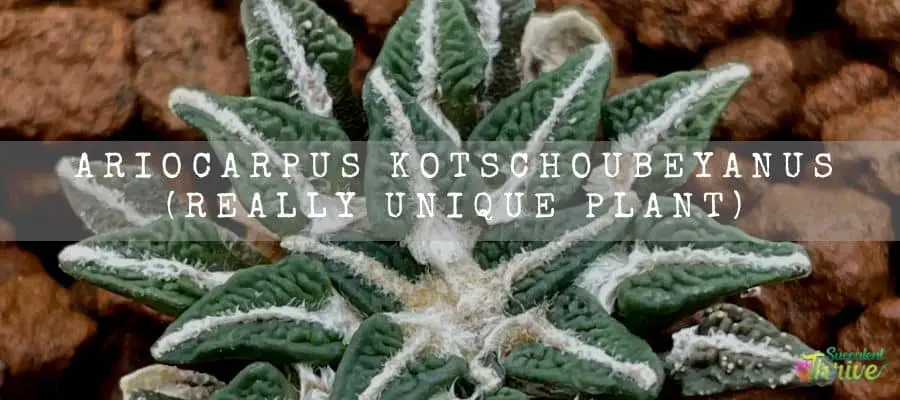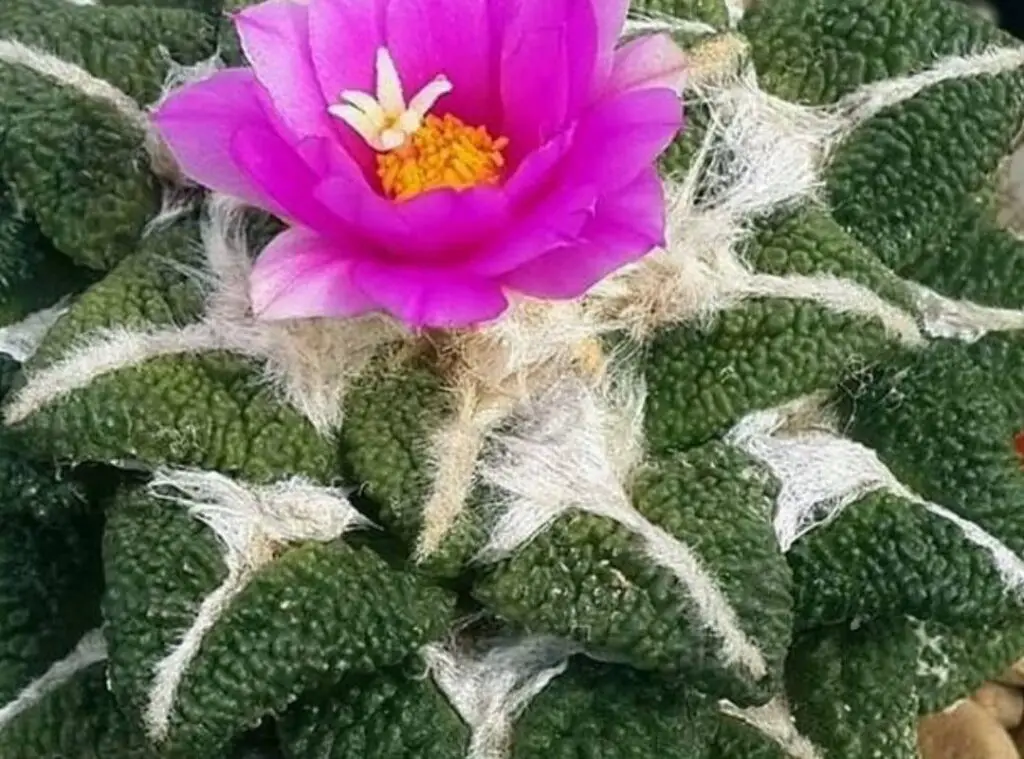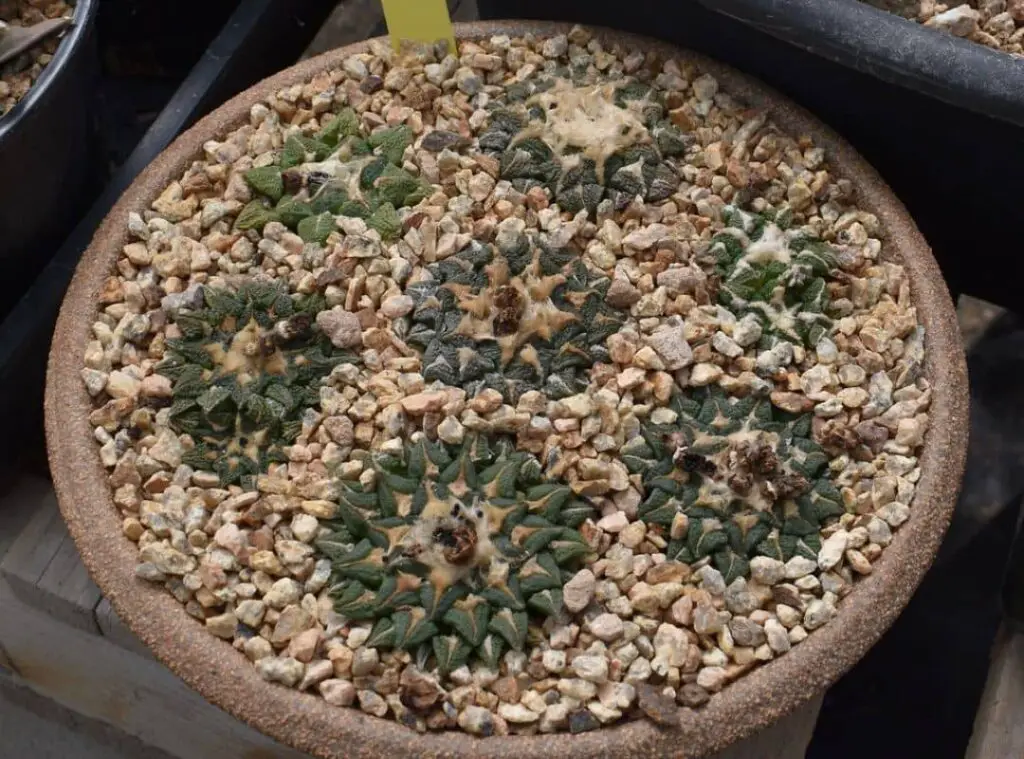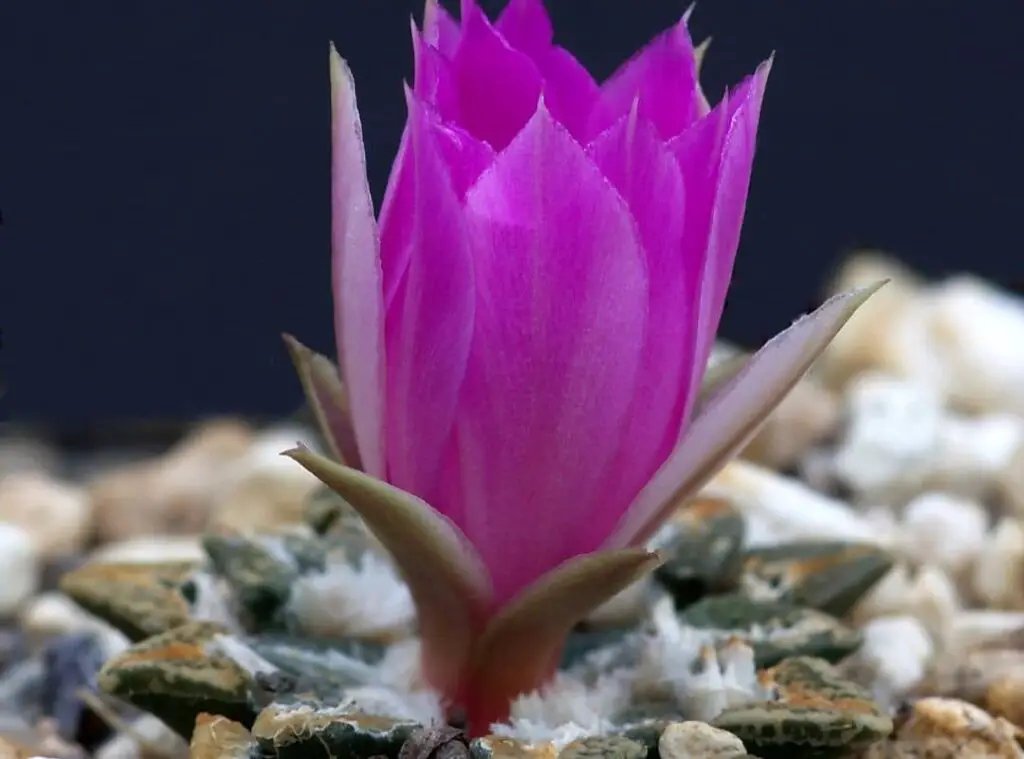Ariocarpus kotschoubeyanus are yet another breathtaking set of plants which you will find in the succulent world.

If I briefly touch on the origin of the plants, they are native to Mexico and to South America as well. They would usually grow as a larger number of small, isolated plants.
They go by the common names called Living rock and Star rocks. Ariocarpus kotschoubeyanus plants would usually develop around 1000-1900 meters altitudes. They would make slit plains and areas in hills as their natural habitats
Botanically speaking, Ariocarpus kotschoubeyanus plants are hard to identify when they grow in the wild as they would make a great combination with mother nature, and you cannot distinguish them in particular.
However, the spotlight of these plants is their spectacular pink blossoms. It is noteworthy when the plants go through hot and dry drought conditions for too long, chances are that the plant part which is above the ground level would tend to develop mold.
Ariocarpus kotschoubeyanus is facing a huge threat in losing their habitats due to new establishments of the humans, dumping wastage , illegal collection etc.
Further the possibility to use them for medical purposes also makes it a threat for them to survive. So, let’s find out more about these exciting plants.
How do I identify Ariocarpus kotschoubeyanus?
Ariocarpus kotschoubeyanus are flat geophyte cactus. Ariocarpus kotschoubeyanus are rosette forming plants and they would usually come up only with one rosette.
The rosette would tend to take a star shape. The leaves would tend to take a dark olive-green color. They may further consist of triangular tubercles. The tubercles would develop a center areolas too.
In terms of the sizes of the Ariocarpus kotschoubeyanus plants, they would be just a few centimeters above the ground.
Further they would form in clumps also. Ariocarpus kotschoubeyanus stem would usually grow solitary. You can spot them bearing areolas rarely too. Those areolas would be flattened on the top and tend to take a depressed manner in the center.
Ariocarpus kotschoubeyanus tubercles would be dark olive green in color. Those tubercles would be longer.
Ariocarpus kotschoubeyanus areoles would be wooly and would be about 1-3 mm in width. Further they would be 5-10mm in length as well. Ariocarpus kotschoubeyanus roots will consist of a large turnip like taproot.
In addition to these features, Ariocarpus kotschoubeyanus produces flowers in bright pink to violet colors. Those flowers will be wider.
Those flowers would stay in bloom for about 4-5 days. They would produce flowers in autumn. Lastly, Ariocarpus kotschoubeyanus emerges with a white or green fruit which comprises a lot of seeds.

Growth rate
Ariocarpus kotschoubeyanus plants grow at a slow pace.
One look care guide
| Botanical Name | Ariocarpus kotschoubeyanus |
| Common Name | Living rock and Star rocks |
| Plant Type | Cactus |
| Mature Size | Few centimeters in height |
| Sun Exposure | Full sunlight to partial shade |
| Soil Type | Well draining |
| Soil pH | Neutral |
| Bloom Time | Autumn |
| Flower Color | Bright pink to violet colors |
| Hardiness Zones | USDA hardiness zones 9a to 11b: from 20 °F (−6.7 °C) to 50 °F (+10 °C). |
| Native Area | Mexico |
| Toxicity | Toxic |
| Average price | 8 USD |
How do you take care of Ariocarpus kotschoubeyanus?
Light Requirement
Ariocarpus kotschoubeyanus plants would flourish given that they can gain full sunlight ideally in the morning hours.
However, when it is the hottest hours of the day, it would be ideal if you place them in a location where they can gain filtered bright sunlight.
If you expose them to excessive sunlight, it will make the plants scorched. I recommend placing the plants in a shady spot during these times so that they will be protected from those adverse conditions.
Temperature and humidity
Warmer temperatures would be optimal for the Ariocarpus kotschoubeyanus plants to grow well. Having said that, they have a frost tolerance up to -10 degrees Celsius. for short periods also.
However, I recommend bringing the plants indoors if you have grown them outdoors during winter. It is advisable to grow the plants exposed to warmer temperatures all round the year.
In terms of the right humidity levels, best would be to grow them while exposing them for low humidity levels. s
Is it cold hardy?
Ariocarpus kotschoubeyanus plants have a frost tolerance up to -10 degrees Celsius.
Growth Zone
Ariocarpus kotschoubeyanus plants prefer to grow in USDA hardiness zones 9a to 11b: from 20 °F (−6.7 °C) to 50 °F (+10 °C).

Watering Requirement
Ariocarpus kotschoubeyanus plants would require a moderate watering to perform well. These are adapted to grow in hot and arid conditions and due to that you need to avoid over watering as much as you can.
You should water the plants Depending on the weather conditions. Ideally you need to water them more often during hot and warmer conditions in summer. to be precise you may water the plants once every week in summer.
On the other hand, you need to cut back on watering in winter. In fact , once a month watering would be adequate for them in winter.
You need to water the Ariocarpus kotschoubeyanus plants in a way where you don’t make their soil too soggy.
Furthermore once you complete watering the plants, make sure that all excess water is draining out from the pots without retaining within.
Soil Requirement Type / pH
I encourage you to use a mineral soil which consists of well-draining materials. I suggest you use a potting mix which consists of materials such as sand, pumice, and perlite.
If you wish you can make an appropriate soil mix on your one to grow these plants. Furthermore, if you don’t have much time to spare on this, you can simply go ahead with the specially made succulents and cactus soil mixes which are available in the gardens stores,
Never use a poor draining soil mix, as it makes the soil retain excess water. Consequently, it would result in the rot of the plants.
If it is essential, you could disinfect the soil mix and then use so that you are sure that it will be completely safe for the plants.
Pot size Potting and Repotting
I suggest you go ahead with either terracotta pots or with clay pots as they are high in porosity.
High porosity is very useful for these plants as they would ensure that there will be no excess moisture retained in the pots.
Furthermore when it comes to repotting the plants, you could consider doing that less often. It would be better if you could repot the plants once you bring them home as chances are that they would have been grown in poor quality soil mixes.
On another note, if you think they have gone through a pest attack, I recommend repotting them as it would provide new growing conditions for the plants.
To do that you may simply remove the plant from the pots and snip off if you find any rotten and decaying plant parts. After that you could treat those cuttings with fungicides and grow them in a fresh pot which is filled with a fresh soil mix.
Fertilizer and time of year
I suggest you feed them with a light cactus fertilizer when they are actively growing.
Flower
During autumn, these plants would emerge with bright pink to violet-colored flowers.

Dormancy
They would go into dormancy during winter
Toxicity
These plants are toxic to kids and pets.
Common bugs and illnesses
Chances are that pests such as mealybugs, aphids could attack these plants occasionally. . Mealybugs would be more like little white cotton organisms.
They would tend to jump out whenever you interrupt them. You could identify the mealybugs from these features. Additionally, overwatering would lead to root rot, bacterial infection and fungal growth as well.
However, if you are proving the right care tips for the plants, they can strongly combat these issues and with the disease.
How to propagate Ariocarpus kotschoubeyanus
You may consider propagating the Ariocarpus kotschoubeyanus plants via seeds propagation method. Grafting is another way of propagating the plants.
Ariocarpus kotschoubeyanus benefits
Ariocarpus kotschoubeyanus plants are handy for container gardening. Furthermore, some people have made use of these plants for medicinal purposes also.
Conclusion
So, to wind up, Ariocarpus kotschoubeyanus plants are some exciting plants which anybody would love to have.
All you need to ensure is that you water them moderately , provide a fast-draining soil mix and expose them for adequate sunlight levels.
If you can provide these three main growing requirements, Ariocarpus kotschoubeyanus plants would flourish to their best ability.
Read Next : Ariocarpus Agavoides | An Uncommon Cactus |
